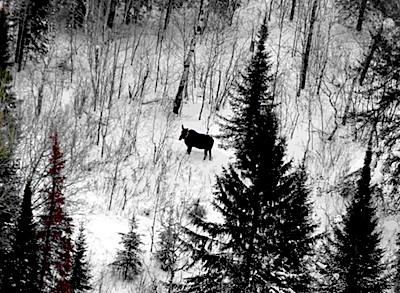
A cow moose spotted during this year's population survey in Voyageurs National Park/NPS
The moose population at Voyageurs National Park in Minnesota seems to be holding its own, according to a recent survey conducted by park biologists. While the herd isn't growning, moose mortality rates in Voyageurs are about half of that found elsewhere in northeastern Minnesota, officials say.
The annual count was held in February and March. The 2014 population estimate for the Kabetogama Peninsula was 40 moose, similar to estimates from 2009-2013 of 41-51. The Kabetogama Peninsula is a 118-square mile roadless area that contains almost all of the park's moose population.
Biologists did observe fewer calves than in the previous three surveys, and the calf:cow ratio of 0.23 was also lower than estimates from 2010-2013 of 0.54-0.61.
Two adult collared moose moved from the park into Ontario a few weeks before the survey began and another died during the survey. If those moose had been present during the survey, the 2014 estimate would have been inside the range of past counts.
Biologists also confirmed the presence of at least three moose in the southern portion of the park. The continued apparent stability of the low-density population in Voyageurs is corroborated through ongoing monitoring of GPS-collared moose. Only one of 14 collared adult moose has died since the last aerial survey was completed in 2013.
Overall, mean annual mortality of adult moose in Voyageurs National Park has been 10 percent since monitoring began in 2010, say park officials. By comparison, annual mortality of adult moose in the declining northeastern Minnesota moose population in recent years has been around 20 percent, they add.
Biologists say warmer annual and summer temperatures may be stressing moose populations in the region. The moose population declined by about 50 percent between 2006-2014 in northeastern Minnesota, and several areas in adjacent Ontario have also documented recent declines. There are likely multiple factors involved in the observed declines including climate-related stresses on health and reproductive status, diseases and parasites, predation, and changes in habitat.
Moose in Voyageurs experience all of these factors, including the brainworm parasites and high densities of wolves and bears. It is unclear if population dynamics in the park are indeed different from those in adjacent areas or if the park, at the western and southern edge of these other populations, will experience similar declines in the near future. Park biologists are continuing studies to understand the complex relationships that drive moose population dynamics in the park.
The National Park Service will continue to monitor the Voyageurs National Park's moose population on an annual basis. In addition, Voyageurs National is investigating other aspects of moose ecology in collaboration with University of Minnesota-Duluth, Bemidji State University, Lakehead University, and other partners. Other studies include how moose behave in response to high temperatures and other weather events, how and why moose use wetlands for foraging and temperature regulation, and the interactions of moose, deer, beavers and wolves. The 2014 Voyageurs National Park Moose Population Survey Report can be downloaded from the NPS website: http://irmafiles.nps.gov/reference/holding/493661.



Add comment